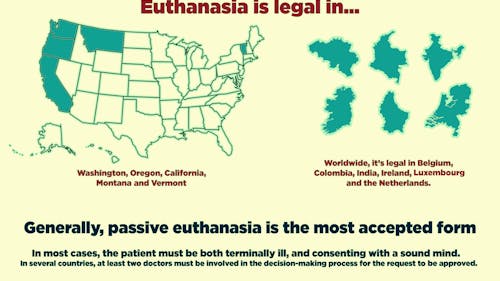Rutgers professor explains debate over euthanasia

Increasingly over the last several years, assisted death or euthanasia has been debated throughout the world and the United States.
Euthanasia is also referred to as “assisted suicide (or) physician-assisted suicide,” as well as “mercy killing,” according to Medical News Today.
It is a controversial subject, with people arguing for and against it, said Larry Temkin, a distinguished professor in the Department of Philosophy.
“Euthanasia is a term of art. We can use it to mean many different things and other considerations. Normally, when we mean euthanasia, we think about putting someone to death,” Temkin said.
Euthanasia can be categorized into three types — voluntary, involuntary and non-voluntary, he said. Voluntary euthanasia involves direct consent from the patient. It also mainly involves self-administration or accepted assistance, usually by a doctor.
Voluntary euthanasia can be active or passive, either directly committing euthanasia, or perhaps, simply withdrawing life-sustaining therapies and medicines, he said.
“You put someone to death, but only because they want you to,” Temkin said. “You could say that you’re respecting that individual’s autonomy. They request to be put to death.”
Involuntary euthanasia is committed against the victim’s will, he said.
“A famous (example) would be when people are worried about euthanasia, they’re worried about the Nazi experiments, where various people who were quite clearly evil, who hated other groups, wanted to euthanize some groups, wanted to kill them off,” he said.
People liken euthanasia to murder because of the Nazi genocide, he said. Euthanasia actually differs from murder due to the intended result. Murder is committed for personal gain, while people euthanize to ease suffering.
Nazis believed their victims were “unfit to live,” and therefore euthanizing them was “easing their suffering,” he said.
The third type is non-voluntary, where a subject cannot indicate consent, either because they are incapacitated or otherwise unable to make a decision. Coma patients are one example of this, he said. Specifically, those in a vegetative state who did not clearly define their wishes in any legal documents are unable to declare their consent.
Being able to indicate consent is an important topic for those who study euthanasia, Temkin said. A person’s agency refers to their ability to represent themselves.
“Beings who are agents are thought to be conscious, self-conscious too, to be individuals who are capable of forming a plan, and following that plan,” Temkin said.
Factors like the mental state of the patient requesting to be euthanized are weighed when granting these requests, he said. Mentally unstable or depressed people are usually denied.
Cultural or societal factors also determine whether patients may be granted permission. In Western cultures, the rights of individuals are placed before the needs of the group, while in Eastern cultures, the needs of the group are considered first, he said.
The debate around whether to legalize euthanasia is an emotional one, he said. The most common arguments are moral implications versus practical ones.
Moral arguments are primarily concerned with whether people have the right to determine the value of a life and whether people can take lives, he said. These are usually based on a person’s own principles.
Practical arguments look at the economics of euthanasia, whether resources might be wasted that could otherwise be used, he said.
The two sides are interconnected, he said. One example would be if a family removed a comatose relative from a ventilator because they could not afford to keep their family member alive. While it is a moral decision, the family would have had to consider their economics.
“I do think it’s a matter of morality. You decide what you morally ought to do. But economics are not irrelevant,” he said.
Five states in America allow euthanasia with a physician’s assistance, according to procon.org. They include California, Oregon, Vermont, Washington and Montana. A judge allowed for it in one specific case in New Mexico, but that ruling was overturned.
Belgium, the Netherlands, Luxembourg, Ireland, Colombia and India have all legalized euthanasia, according to multiple news sources. Switzerland, Germany, Japan, Albania and Canada have also legalized assisted suicide, which they define differently.
Assisted suicide is different from euthanasia in that the former requires the patient to carry out the act of ending their life, according to patientsrightscouncil.org.
Most of these countries require terminally ill patients to have a sound mind, and in several nations, at least two doctors are required to approve the process.
Euthanasia would likely not be legalized in the United States on a federal level anytime soon, Temkin said. It would set an important precedent if it was.
____
Nikhilesh De is a School of Engineering junior. He is the news editor of The Daily Targum. Follow him on Twitter @nikhileshde for more.
Jonathan Xiong is a School of Arts and Sciences sophomore majoring in biology. He is a contributing writer for The Daily Targum. See more on Twitter @ra567.



